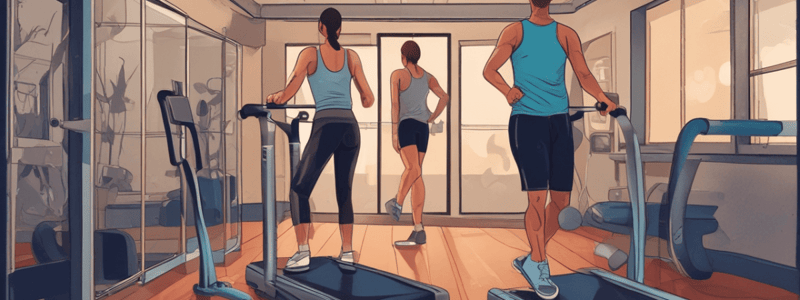Podcast
Questions and Answers
Which exercise is primarily included to strengthen the protractors in the scapular strengthening routine?
Which exercise is primarily included to strengthen the protractors in the scapular strengthening routine?
- Rows
- Scapular plane elevation
- Push up plus (correct)
- Press-ups
Which of the following exercises is NOT listed under scapular strengthening?
Which of the following exercises is NOT listed under scapular strengthening?
- Prone extension (correct)
- Rows
- Press-ups
- Protraction
During isotonic rotator cuff exercises, what movements are performed with a theratube or theraband?
During isotonic rotator cuff exercises, what movements are performed with a theratube or theraband?
- ER and IR (correct)
- Flexion and extension
- Circumduction
- Abduction and adduction
What change is suggested for progressing submaximal isometric exercises?
What change is suggested for progressing submaximal isometric exercises?
Active flexion during isotonic rotator cuff exercises initially targets what range of motion?
Active flexion during isotonic rotator cuff exercises initially targets what range of motion?
To increase resistance in prone extension exercises, how much weight is suggested?
To increase resistance in prone extension exercises, how much weight is suggested?
Which factor is not listed as influencing the outcome of shoulder impingement/rotator cuff tendinitis?
Which factor is not listed as influencing the outcome of shoulder impingement/rotator cuff tendinitis?
When might surgical intervention be considered for shoulder impingement/rotator cuff tendinitis?
When might surgical intervention be considered for shoulder impingement/rotator cuff tendinitis?
Which statement is correct regarding shoulder impingement/rotator cuff tendinitis based on the given content?
Which statement is correct regarding shoulder impingement/rotator cuff tendinitis based on the given content?
Which of the following is true about the complexity of shoulder impingement/rotator cuff tendinitis?
Which of the following is true about the complexity of shoulder impingement/rotator cuff tendinitis?
Which aspect is not a determinant of outcomes in shoulder impingement/rotator cuff tendinitis?
Which aspect is not a determinant of outcomes in shoulder impingement/rotator cuff tendinitis?
Which exercise is used to continue and advance scapular strengthening?
Which exercise is used to continue and advance scapular strengthening?
How should the rotator cuff strengthening for external and internal rotations progress?
How should the rotator cuff strengthening for external and internal rotations progress?
What is a careful inclusion during gradual return to previous activities?
What is a careful inclusion during gradual return to previous activities?
At the end of Phase II, what type of functional activity simulation is suggested?
At the end of Phase II, what type of functional activity simulation is suggested?
Which exercise should be performed with the thumb up?
Which exercise should be performed with the thumb up?
Which of the following is NOT an example of a rotator cuff exercise mentioned?
Which of the following is NOT an example of a rotator cuff exercise mentioned?
Flashcards are hidden until you start studying
Study Notes
Conservative Management: Phase II
Treatment
- Strengthening exercises:
- Progressively increase resistance of existing exercises
- Incorporate scapular strengthening exercises: rows, scapular plane elevation, press-ups, push-ups, and protraction
- Include "push up plus" to work the protractors
- Isotonic rotator cuff exercises:
- External rotation (ER) and internal rotation (IR) with theratube/theraband, at the side of the body
- Active flexion: 0-45 degrees and then 0-90 degrees
Strengthening (cont'd)
- Progress strengthening program at the end of Phase II
- Continue and advance scapular strengthening:
- Plyo toss
- Increase resistance/demand of previous exercises
- Rotator cuff:
- ER and IR progressing from side of the body to 45 degrees to 90 degrees
- Standing flexion and abduction: 0-180 degrees with thumb up
Return to Activities
- Gradual return to previous activities
- Careful inclusion of overhead reaching
- Functional activity simulation
Outcomes/Prognosis
- Shoulder impingement/rotator cuff tendinitis is a complex problem
- Outcomes depend on:
- Cause of the problem
- Severity of the problem
- Patient's age
- Patient's dedication to the rehabilitation process
- Surgical intervention may be considered if conservative management fails
Studying That Suits You
Use AI to generate personalized quizzes and flashcards to suit your learning preferences.



